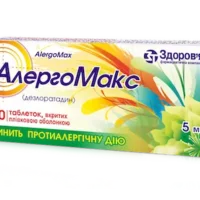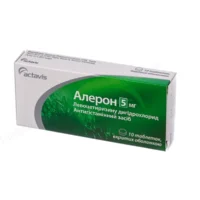Description
Eslotin (Desloratadine) Coated Tablets 5 mg. № 30
Ingredients:
Each tablet contains 5 mg of desloratadine.
Dosage:
The recommended dosage is one tablet daily.
Indications:
Eslotin tablets are indicated for the relief of symptoms associated with allergic rhinitis and chronic idiopathic urticaria.
Contraindications:
Do not use Eslotin if you are allergic to desloratadine or any other ingredients in the tablets.
Directions:
Swallow the tablet whole with water. Do not crush or chew the tablet.
Scientific Evidence:
Eslotin (desloratadine) is a second-generation antihistamine that exhibits selective peripheral H1-antagonist activity. It works by blocking the action of histamine, a substance in the body that causes allergic symptoms. Clinical trials have shown that desloratadine is effective in relieving symptoms of allergic rhinitis and chronic idiopathic urticaria with a low incidence of sedation compared to first-generation antihistamines.
Additional Information:
It is important to note that Eslotin may cause drowsiness in some individuals, so caution should be exercised when driving or operating machinery. Consult your healthcare provider before using Eslotin if you have liver or kidney impairment. Keep out of reach of children and store at room temperature.
Pharmacological Effects:
Desloratadine, the active ingredient in Eslotin, exerts its pharmacological effects by competitively antagonizing histamine at H1 receptors. By blocking the histamine receptors, desloratadine prevents the allergic response, thereby reducing symptoms such as itching, sneezing, and nasal congestion. This mechanism of action provides relief from allergic conditions without causing significant sedation, making it a preferred choice for many patients.
Clinical Trials and Comparative Effectiveness:
Several clinical studies have demonstrated the efficacy of desloratadine in the treatment of allergic rhinitis and chronic idiopathic urticaria. A study published in the Journal of Allergy and Clinical Immunology showed that desloratadine provided significant symptom relief compared to a placebo in patients with allergic rhinitis. Furthermore, desloratadine has been shown to have a longer duration of action and a better safety profile compared to older antihistamines like diphenhydramine. This makes Eslotin a valuable option for individuals seeking effective and well-tolerated allergy relief.





